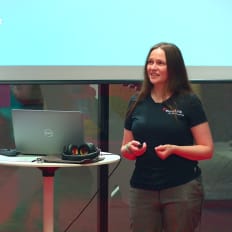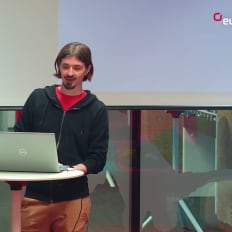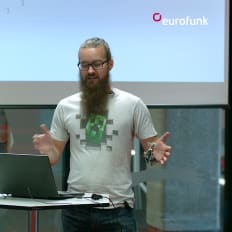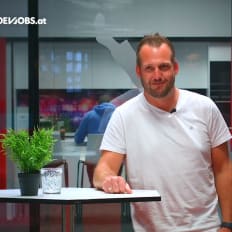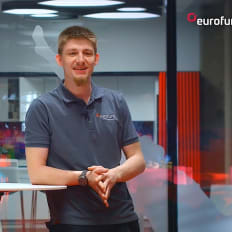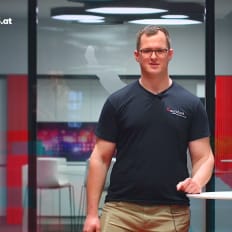
eurofunk Kappacher GmbH
Valentin Zintl, Junior Development Engineer bei eurofunk Kappacher
Description
Valentin Zintl von eurofunk Kappacher erzählt im Interview über seinen Karriereweg, welche Aufgaben ihn täglich erwarten und welche Fähigkeiten besonders für den Einstieg wichtig sind.
By playing the video, you agree to data transfer to YouTube and acknowledge the privacy policy.
Video Summary
In "Valentin Zintl, Junior Development Engineer bei eurofunk Kappacher," Speaker: Valentin Zintl explains how he stumbled into software during civilian service, completed a four-year apprenticeship as an application developer/coder at eurofunk, and has been a Junior Developer for a year. He describes work ranging from C# on a communications system and test automation with Robot tests to full-stack development with Java and TypeScript on an incident management system, highlighting a culture that encourages exploring new areas with supportive colleagues. His advice to newcomers: just start, don’t be intimidated by the breadth—pick a part, use tutorials and YouTube, and keep learning.
From Serendipity to Full‑Stack: The learning curve of Valentin Zintl, Junior Development Engineer at eurofunk Kappacher GmbH
A devstory that lowers the barrier to entry
In our devstory session “Valentin Zintl, Junior Development Engineer bei eurofunk Kappacher,” speaker Valentin Zintl offers a clear, down‑to‑earth account of how a software career can start not with a grand plan, but with curiosity and a timely opportunity. He describes how he moved from a general secondary school track to alternative paths during civil service, then discovered the apprenticeship “Applikationsentwickler und Coder,” applied at eurofunk, completed four years of training, and has now been a Junior Developer for a year.
Along the way, he has worked with C# on a communications system, contributed to test automation by writing Robot tests, and transitioned into a full‑stack role using Java and TypeScript on an incident management system. The through‑line is simple and powerful: “just start,” don’t be intimidated by the field’s breadth, pick one area to begin with, and never stop learning.
A detour that became direction
Valentin sums up his entry bluntly: he “came into software development more by chance.” He first attended a general secondary school but realized “it might not be my thing,” and studying didn’t feel right either. During civil service, he explored options and “happened to come across the apprenticeship Applikationsentwickler und Coder.” He applied to eurofunk, started the apprenticeship, completed it over four years, and has now been a Junior Developer for a year.
This sequence—school, civil service, apprenticeship, junior role—reminds us that software careers are not one‑size‑fits‑all. What matters is the moment when interest meets a tangible path. For Valentin, that path was the apprenticeship at eurofunk Kappacher GmbH.
Learning by doing: four formative years
Looking back, Valentin says he “saw a lot,” especially because of the apprenticeship. That short line captures something essential: effective training in software exposes you to different parts of the system. In his case, that meant stepping across several layers rather than staying confined to one tool or technology:
- Building in C# on a communications system
- Contributing to test automation with Robot tests
- Moving into full‑stack development with Java and TypeScript on an incident management system
This breadth—back‑end, quality, and full‑stack—pays dividends. It sharpens the ability to connect implementation details with system behavior and user outcomes.
Milestones in the stack: C#, Robot tests, Java, and TypeScript
C# on a communications system
During the apprenticeship, Valentin “developed a lot in C‑Sharp” on the company’s communications system. Communication platforms demand clarity around APIs, stability, and robust error handling. Learning in such an environment forces structured thinking and reliable software habits.
Test automation with Robot tests
Valentin was “involved in test automation” and “wrote Robot tests.” Early ownership in testing builds quality instincts—it brings testability, determinism, and separation of concerns into focus not only at the end of development, but already during design.
Full‑stack with Java and TypeScript on an incident management system
More recently, he’s been “working as a full‑stack developer” and building “with Java and TypeScript” on the incident management system. Full‑stack work bridges back‑end logic and front‑end interaction. Following C# and test automation, this progression makes sense: start with core development practices, internalize quality, and then expand to the broader full‑stack perspective.
Culture as a multiplier: permission to explore, colleagues who help
Valentin emphasizes a cultural pattern that stands out: “There are many different topics” at work, and “there’s no barrier” if you “want to try something new.” Colleagues are “always very helpful”—if you’re exploring a new area, “they show you what needs to be done.”
That’s not a footnote. Learning paths are built by culture. Where exploration is encouraged, T‑shaped growth becomes likely—deepening in one area while developing useful breadth in adjacent ones. Valentin’s trajectory—C#, testing, full‑stack—reflects precisely that openness.
Against overwhelm: “just start”
Valentin admits he felt intimidated by the size of the field at the beginning: a “huge topic,” so many frameworks, so many “areas,” and the fear of not keeping up. His antidote is disarmingly simple:
“In the end, you just have to pick a part, start, and over time you get used to it.”
He also recommends tutorials and YouTube videos as accessible entry points—and stresses “do not be intimidated.”
For anyone standing at the starting line, that’s essential guidance. It’s not the perfectly curated roadmap that moves you forward, but the willingness to take a small step now—and to keep going.
“You never stop learning”: mindset over tools
Valentin’s closing cue is clear: “You never stop learning… you should always be ready to learn something new and develop yourself.” That mindset connects his milestones:
- From first C# commits to full‑stack tickets
- From first Robot tests to ongoing refactoring
- From first tutorials to shipped features
Tools matter, but mindset compounds. It’s the commitment to continuous learning that turns exposure into expertise.
Practical steps for beginners—inspired by Valentin’s path
Staying strictly within what Valentin shared, we can distill actionable steps for anyone starting out:
- Let interest lead—and make it specific
- Ask: What part of software excites you? Web, back‑end, testing, automation?
- Follow Valentin’s advice: pick “one part” and begin there.
- Start small—truly small
- One tutorial. A tiny sample project. A single test.
- The goal is momentum, not completeness.
- Use low‑barrier learning media
- Tutorials and YouTube videos are valid starting points.
- The key is to implement: watch, rebuild, then vary.
- Meet testing early
- Test automation and Robot tests show how quality becomes measurable.
- Building a feel for stability early pays off later.
- Allow breadth, choose depth
- Like Valentin: from back‑end to testing to full‑stack.
- Breadth expands perspective; depth sharpens decisions.
- Seek help—and accept it
- Colleagues who “show you what needs to be done” accelerate learning.
- Explore in a culture that encourages it.
- Make learning a habit
- “You never stop learning” is a practice, not a slogan.
- Budget time to explore and to repeat what you’re learning.
How teams can support—what we infer from Valentin’s remarks
Valentin’s story implies three supportive team habits:
- Treat topic variety as an asset: Seeing “a lot” helps juniors connect dots.
- Give explicit permission to explore: “There’s no barrier” when someone wants to try new things.
- Make help routine: If colleagues “show what needs to be done,” learning becomes normalized.
For onboarding and training, that translates into real tasks, guided practice, and encouragement to switch contexts—without expecting anyone to master everything at once.
From “too much” to a workable loop
Most of us know the feeling: long lists of frameworks, architecture diagrams, best‑practice checklists—overwhelm. Valentin’s “just start” approach can be structured into three loops:
- Choose a focus: one problem, one feature, one test case.
- Implement: in small increments with immediate feedback (a test result, a page rendering, a log entry).
- Reflect: What worked? What was too big? What’s the next smallest step?
These loops apply equally to C#, Java/TypeScript, and test automation. The key is repetition—and the resolve to continue even when progress feels slow.
Bridges between disciplines
Valentin’s path crosses disciplines that reinforce one another:
- C# development builds discipline around models and interfaces.
- Test automation enforces clarity of behavior—software must be testable to be maintainable.
- Full‑stack work connects business logic to interaction—software must not only be correct, but understandable and usable.
Building these bridges helps developers tie code decisions to product outcomes. That integrative thinking marks the transition from novice to seasoned contributor.
Quotes that stick
“The best way is simply to start.”
“Don’t be intimidated.”
“You never stop learning.”
“There’s no barrier if you want to try something new.”
They’re easy to say and hard to live by—which is precisely why they matter.
One year as a junior—and why it’s pivotal
Valentin has been “a Junior Developer for a year.” It’s a pivotal phase: you know enough to contribute productively and too little to stop learning. The mindset he describes—curiosity, respect for the field’s breadth, and the willingness to “always be ready to learn something new”—is exactly what a strong junior year calls for.
Those four apprenticeship years put weight behind that mindset. You learn to ask questions early, adopt standards, think about quality from the start, and grow into new technologies.
Practical moves you can make today
Distilled from Valentin’s devstory, here are practical, no‑nonsense moves you can take now:
- Pick a tiny real use case—a mini tool, a simple UI form, or a single API behavior.
- Build it in your closest language (e.g., C# or Java) and add one automated test.
- Open a second door: if you start back‑end, peek into front‑end (TypeScript). If you start front‑end, write a small test.
- Seek feedback. Colleagues, communities, forums—what matters is feedback on something concrete.
- Use tutorials as a start—but finish with your own variation.
- Keep steps small and visible. Inches of progress beat miles of planning.
None of this is fancy—but it’s reliable. Just like Valentin’s “simply start.”
Why this path resonates
- It’s honest: not a masterplan, but timely decisions that add up.
- It’s broad: C#, testing, Java/TypeScript—breadth that creates leverage.
- It’s people‑centric: helpful colleagues, permission to explore.
- It’s learning‑oriented: “you never stop learning” as a working principle.
Taken together, this is how sustainable growth in software looks: step by step, topic by topic, supported by a culture that enables both.
Closing: Start, persist, keep learning
“The best way is simply to start,” says Valentin Zintl. For those interested in software development, countless entry points exist—tutorials, videos, small projects. What matters is taking the first step, refusing to be intimidated, and shaping your learning curve deliberately. Valentin’s journey—from general schooling through civil service to the apprenticeship, and on to a junior role at eurofunk Kappacher GmbH—shows how powerful that approach can be:
- Start with one part.
- Learn by doing—and by testing.
- Broaden your scope when you’re ready.
- Seek and offer help.
- Stay curious.
As the DevJobs.at editorial team, our takeaway from “Valentin Zintl, Junior Development Engineer bei eurofunk Kappacher” is simple and strong: A good developer journey rarely begins with a perfect plan—but almost always with a small first step. Then the next. And the next.
More Tech Talks
eurofunk Kappacher GmbH From Sound to Sense
Sabine Hasenleithner von eurofunk Kappacher spricht in ihrem devjobs.at TechTalk über die technischen Hintergründe von Sprach Erkennung im Notruf Kontext und zeigt in einer Live Demo eine mögliche Implementierung.
Watch noweurofunk Kappacher GmbH Effortless Versioning
Stefan Höller von eurofunk Kappacher zeigt in seinem devjobs.at TechTalk, wie das Unternehmen die Versionsverwaltung bei langen Produktzyklen mithilfe von Semantic Release gestaltet hat.
Watch noweurofunk Kappacher GmbH Cypress Component Tests
Patrick Pichler von eurofunk Kappacher demonstriert in seinem devjobs.at TechTalk die Herangehensweise des Teams, wie sie Component Tests mit cypress durchführen.
Watch noweurofunk Kappacher GmbH Application Load Testing with k6
Daniel Knittl-Frank von eurofunk Kappacher spricht in seinem devjobs.at TechTalk darüber, wie die hohen Performance Anforderungen der im Unternehmen entwickelten Software erfüllt werden.
Watch now
More Tech Lead Stories
eurofunk Kappacher GmbH Thomas Ronacher, Head of Technical Support bei eurofunk Kappacher
Thomas Ronacher von eurofunk Kappacher spricht im Interview über die Struktur des Teams, die verwendeten Technologien und wie der Bewerbungs- und Onboardingprozess abläuft.
Watch noweurofunk Kappacher GmbH Johanna Blum, Release Train Engineer bei eurofunk Kappacher
Johanna Blum von eurofunk Kappacher beleuchtet im Interview die Teamkultur, die wichtigsten Technologien im Einsatz und die Besonderheiten des Recruiting-Prozesses.
Watch now
More Dev Stories
eurofunk Kappacher GmbH Viktoria Haselsteiner, Scrum Master bei eurofunk Kappacher
Viktoria Haselsteiner von eurofunk Kappacher spricht im Interview über ihren Einstieg in die Welt von Scrum, welche Fähigkeiten sie dabei als besonders hilfreich erlebt hat und worauf es ihrer Meinung nach in der täglichen Arbeit wirklich ankommt.
Watch noweurofunk Kappacher GmbH Maximilian Spiesmaier, IT Security Consultant bei eurofunk Kappacher
Maximilian Spiesmaier von eurofunk Kappacher teilt im Interview seine Erfahrungen aus der IT Security, welche Herausforderungen er im Arbeitsalltag meistert und wie man am besten in den Beruf startet.
Watch noweurofunk Kappacher GmbH Johannes Festi, Trainee Software Development bei eurofunk Kappacher
Johannes Festi von eurofunk Kappacher gibt im Interview Einblicke in den Arbeitsalltag als Software Development Trainee, wie er dazu gekommen ist und was seiner Ansicht nach wichtig für den Einstieg ist.
Watch now

